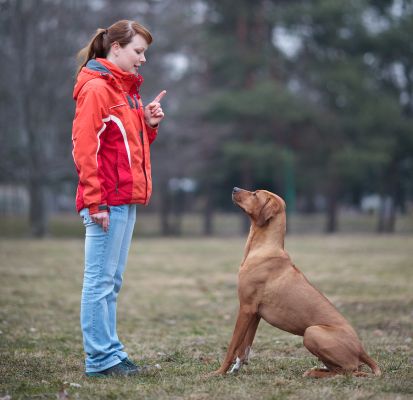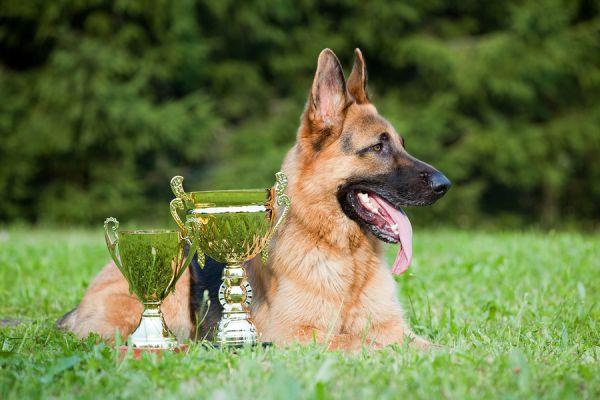
This is a placeholder text
Group text
An Introduction to Competitive Obedience
Everyone is familiar with sit, down, and come and other similar commands that are standard fare in the general obedience training class. The novice handler might not be familiar with what competitive obedience looks like or realize that it’s really just a continuation of those basic skills.
What is Competitive Obedience?
 What makes competitive obedience different from general pet dog obedience is the exactness of the skills. As a pet dog in daily life, being 100% reliable isn’t always required, depending on the owner. The dog doesn’t have to be as sharp, quick, or positioned just right. He isn’t always watching you.
What makes competitive obedience different from general pet dog obedience is the exactness of the skills. As a pet dog in daily life, being 100% reliable isn’t always required, depending on the owner. The dog doesn’t have to be as sharp, quick, or positioned just right. He isn’t always watching you.Competitive obedience requires the dog and handler to be on the top of their game. Position is very important in competitions. A dog in heel position (while walking or stopped by handler) should line their right shoulder up as closely with the handler’s left pant leg seam as possible. Too far forward, too far behind, or too wide are all faults.
Ideally the dog is operating at 110% at all times. The faster the dog responds to commands, the better it pays attention to his handler and blocks out external stimuli, and the more exact it is in its performance, the higher the score the dog and handler team will receive.
Each dog and handler team receives a score in a show based on that team’s performance, but they are also ranked in comparison with the other dogs in the show. The dog will be ranked against dogs within its class for 1st-4th position as well as compared against all of the dogs in the trial for awards like High in Trial.
What are the Kinds of Obedience Levels and Shows?
The American Kennel Club (AKC) is the most available option for competitive obedience in the United States. It provides a lot of opportunities throughout the country and year through local club shows.Other areas in the world have obedience trials organized through their respective kennel clubs like the Canadian Kennel Club in Canada, the Kennel Club in England, etc.
While each kennel club provides its own rules for competitive obedience and trialing, in general you will see some of these skills:
Novice Level:
- Heeling: This is an on-leash pattern of walking with the dog in tight formation next to the handler (on the left hand side of the handler). There is also on off-leash pattern.
- Sit/Down: These are used in conjunction with other commands.
- Recall: A handler is asked to leave their dog and cross the ring for a recall when the judge requests it.
- Stand for Exam: This is a stay command while the dog is standing. Then, a judge will approach the dog and lightly touch the dog before allowing the handler to return to the dog.
- Stay: This is a 2 part exercise with the dog staying both in a sit position and a down position for a duration of time. The dog will be left in a line with other dogs while you are directly across from him on the other side of the ring.
More Advanced Levels: There are normally at least 2 more levels which get progressionally more difficult. You will likely encounter exercises like:
- Heeling: Off leash healing only and the pattern is more difficult.
- Jumping: Jumps are included whether that is jumping over a panel jump, jumping over a broad jump, or in the most advanced level, jumping over the jump indicated by the handler.
- Recall: Recall work includes retrieving a dumbbell and going over a jump.
- Retrieval: This includes the aforementioned retrieval of the dumbbell over a jump during a recall, but there is also a recall on the flat ground too.
- Drop: During one recall, the judge will signal when you must ask for your dog to drop into a down position on the way to you.
- Stay: The positions are again sit and down in a line of dogs, but the time required for the stays is longer. The handler also leaves the ring for out of sight stays.
- Send Out: This is where the handler sends the dog out across the ring.
- Scent discrimination: In most advanced levels, there is scent discrimination work where the dog must identify the correctly scented item.
The Schutzhund sport also provides another option for competitive obedience, although it is a little different in style. First, there is the requirement of passing what is known as the BH prior to moving into any Schutzhund trialing. The BH is a formal obedience and traffic test which is used to not only gauge obedience but also a test of temperament.

The test includes different obedience items like:
- Heeling: This is similar to other competitive venues where the dog and handler perform a pattern of walking.
- Sit and Down While in Motion: This is where the dog and handler are walking in heel and on command, the dog will sit or down (and stay put) while the handler continues in motion.
- Down under Distraction: A dog is downed and the handler moves away from the dog while another dog works.
- Traffic Test: This is demonstrating controlled obedience and walking throughout real world tests which include encountering bikers, skaters, cars, other dogs, and a group of people.
- Heeling: What makes this heeling different from other competitive obedience trials is that the dog will be asked to walk in and around other people and throughout gunshots being fired.
- Sit, Down, and Stand in Motion: This is the dog assuming a position when commanded to while the handler continues to move.
- Recall: The dogs are recalled out of the positions from above.
- Retrieval: Dogs are asked to retrieve large dumbbells thrown over flat ground, over a hurdle, and over a wall.
- Send Out: The dog is to run out in a line away from the handler on command.
- Down under Distraction: Like in the BH, the dog is held in a down stay while the next dog performs the obedience test.
Where to Begin?
Most people get started in competitive obedience because they join a general obedience class with their dog and enjoy it. Competitive obedience becomes a natural progression for the handler to stay involved in the sport and work with their dog.Some basic training class trainers are not competitive obedience trainers, so if you find yourself wanting to progress to sport, you might need to change trainers. Local kennel clubs are often good places to look for competition classes, practice matches (unofficial shows), and fellow competitors. They will guide you in the refinement that is necessary for competition.
Contact information Disclaimer Privacy Statement Copyright Information Terms of Service Cookie policy ↑ Back to top




